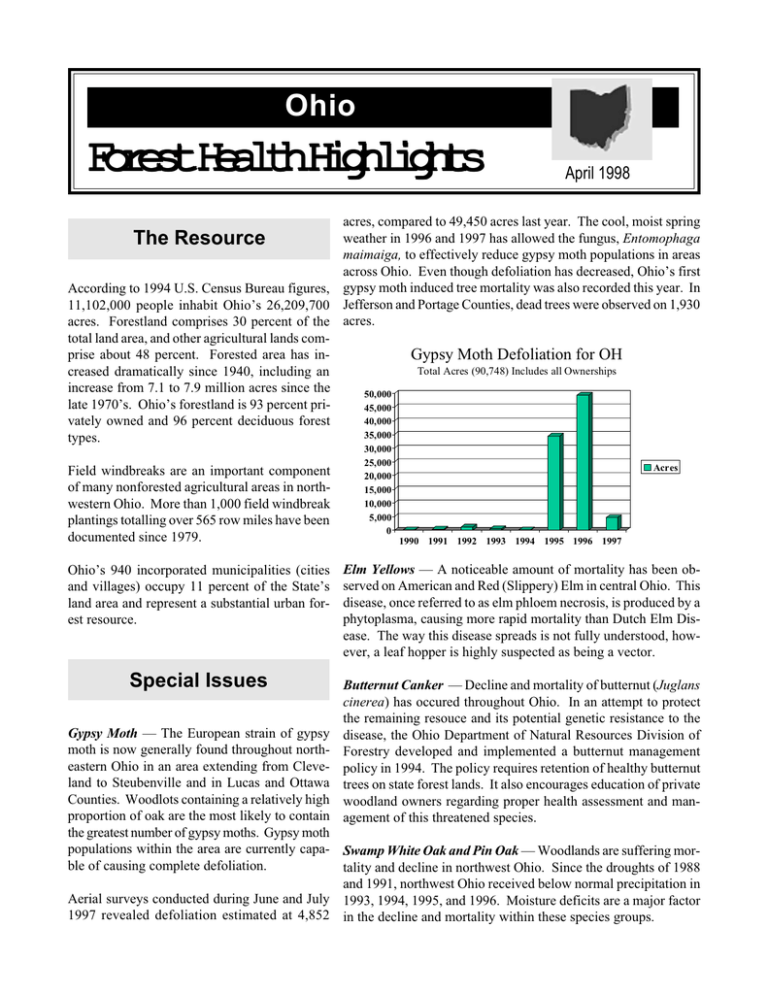Forest Health Highlights
advertisement

Ohio ForestHealthHighlights April 1998 acres, compared to 49,450 acres last year. The cool, moist spring weather in 1996 and 1997 has allowed the fungus, Entomophaga maimaiga, to effectively reduce gypsy moth populations in areas across Ohio. Even though defoliation has decreased, Ohios first According to 1994 U.S. Census Bureau figures, gypsy moth induced tree mortality was also recorded this year. In 11,102,000 people inhabit Ohios 26,209,700 Jefferson and Portage Counties, dead trees were observed on 1,930 acres. Forestland comprises 30 percent of the acres. total land area, and other agricultural lands comprise about 48 percent. Forested area has inGypsy Moth Defoliation for OH Total Acres (90,748) Includes all Ownerships creased dramatically since 1940, including an increase from 7.1 to 7.9 million acres since the 50,000 late 1970s. Ohios forestland is 93 percent pri45,000 40,000 vately owned and 96 percent deciduous forest 35,000 types. The Resource Field windbreaks are an important component of many nonforested agricultural areas in northwestern Ohio. More than 1,000 field windbreak plantings totalling over 565 row miles have been documented since 1979. Ohios 940 incorporated municipalities (cities and villages) occupy 11 percent of the States land area and represent a substantial urban forest resource. Special Issues 30,000 25,000 20,000 15,000 10,000 5,000 0 Acres 1990 1991 1992 1993 1994 1995 1996 1997 Elm Yellows A noticeable amount of mortality has been observed on American and Red (Slippery) Elm in central Ohio. This disease, once referred to as elm phloem necrosis, is produced by a phytoplasma, causing more rapid mortality than Dutch Elm Disease. The way this disease spreads is not fully understood, however, a leaf hopper is highly suspected as being a vector. Butternut Canker Decline and mortality of butternut (Juglans cinerea) has occured throughout Ohio. In an attempt to protect the remaining resouce and its potential genetic resistance to the disease, the Ohio Department of Natural Resources Division of Forestry developed and implemented a butternut management policy in 1994. The policy requires retention of healthy butternut trees on state forest lands. It also encourages education of private woodland owners regarding proper health assessment and management of this threatened species. Gypsy Moth The European strain of gypsy moth is now generally found throughout northeastern Ohio in an area extending from Cleveland to Steubenville and in Lucas and Ottawa Counties. Woodlots containing a relatively high proportion of oak are the most likely to contain the greatest number of gypsy moths. Gypsy moth populations within the area are currently capa- Swamp White Oak and Pin Oak Woodlands are suffering morble of causing complete defoliation. tality and decline in northwest Ohio. Since the droughts of 1988 and 1991, northwest Ohio received below normal precipitation in Aerial surveys conducted during June and July 1993, 1994, 1995, and 1996. Moisture deficits are a major factor 1997 revealed defoliation estimated at 4,852 in the decline and mortality within these species groups. Regional Surveys North American Maple Project (NAMP) In 1992, NAMP plots were established in Geauga, Lake, and Trumbull counties in northeastern Ohio. NAMP is a Canadian/U.S. project investigating concerns about sugar maple health. Study plots are located in active sugarbushes. Through 1996, sugar maples have been healthy in the monitored plots. Some trees, however, have been injured or defoliated by pear thrips. Injury associated with feeding by loopers has also been detected. Windthrow caused by severe storms in 1993 and 1994 reduced stocking in some stands, but average annual mortality remains less than 1 percent. Ohio ranks fourth in the naton in maple syrup production. Lichens A lichen survey was conducted on Ohios state forests in 1997. On most state forests, this initial lichen survey establishes the baseline for future air quality monitoring studies. Shawnee State Forest was surveyed in 1984 and 1997. The 1997 data revealed a stable and diverse lichen population over the past 13 years, indicating that air quality in this region remained good during the same period. Yellow Creek and Fernwood State Forests are located in an area where air quality has been historically poor and lichen populations were degenerating. Our surveys of these forests showed lichen populations were lower than in other areas of Ohio, but recovering. The objective of using lichens as bioindicators is to qualitatively document the historical sulfur dioxide exposure of various forested locations in the state. It is important to note that the impact of air quality, specifically sulfur dioxide, on Ohio forests is not clearly understood. Scarlet Oak Sawfly Larvae In Lawrence, Scioto, and Adams Counties this past summer (1997), the oak foliage exhibited damage caused by the feeding of scarlet oak sawfly larvae. This insect skeletonized the upper 1/3 to 1/2 of tree crowns on scarlet, black, red, pin, and white oaks. The damage, appearing as browning tree tops, was moderate in severity and scattered throughout 76,550 acres in affected counties. Black oaks along ridge tops and pin oaks in bottoms were reported to be most affected. Natural enemies normally control scarlet oak sawfly populations. The Division of Forestry will survey for this insect again in 1998. Urban Forests Measurable management activities indicate that Ohio communities are committed to managing their urban forest resource. Data from 1992-1997 shows that Ohio communities are annually planting more than 3 times as many trees as they remove, while maintaining more trees than they plant each year. In addition, more than 200 of the 940 Ohio communities currently enjoy Tree City USA status. These trends show how sustained comprehensive urban forestry programs implemented by Ohio communities result in healthier, safer, and more functional urban forests. Forest Fire Protection Since most of Ohios forests are privately owned, there is a need to protect these lands from uncontrolled forest fire through a coordinated rural fire response system. This responsibility falls to the State Forestry agency and rural volunteer fire departments. The Rural Community Fire Protection (RCFP) program, a cooperative state/federal effort, helps to improve the capability of 900 Ohio rural fire departments. In 1997, 11 volunteer fire departments in the State received $34,557 in RCFP funds for training and equipment. ForMoreInformation Ohio Department of Natural Resources Division of Forestry 1855 Fountain Square, H-1 Columbus, OH 43224-1327 Phone: 614/265-6694 Web: http://www.hcs.ohio-state.edu/ODNR/Forestry.htm USDA Forest Service Northeastern Area State and Private Forestry Forest Health Protection 180 Canfield Street Morgantown, WV 26505 Phone: 304/285-1541







